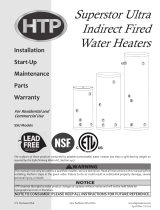Page is loading ...

8
LP-181 Rev. 3.25.14
D. TYPICAL INSTALLATION
Figure 3 – Typical Storage Tank Installation
E. POTABLE EXPANSION TANK
A thermal expansion tank is required in the system designed for potable water use, to offset the expansion of stored water as the
temperature is elevated.
PART 4 – CONTROL AND WIRING
A. CONTROL
A pre-wired surface mount control is provided on your storage tank. Temperature may be set by removing lower cover screw and lower
cover.
B. WIRING
All wiring is to be done in accordance with all applicable local and state codes. Turn off all power related to the boiler before starting any
wiring procedures.

9
LP-181 Rev. 3.25.14
Figure 4 – Wiring the Control
PART 5 – OPERATING THE STORAGE TANK
Boiler high limit should be set at least 20
o
F higher than the storage tank temperature setting. Some boilers will require a low
temperature setting to maintain domestic demand.
We recommend a storage tank temperature setting of 120
o
F. However, a lower temperature setting may be required to comply with
local and state codes for normal operation. You may prefer a setting of either higher or lower water temperature. A mixing valve in
conjunction with a high temperature setting may be used for high demand applications (spas, hot tubs, whirlpools).
If draining of the storage tank is necessary, open the temperature and pressure valve or a hot water tap to prevent vacuum buildup in
the tank and piping.
A temperature limiting or mixing valve is not entirely necessary, but recommended in installations servicing disabled or elderly persons,
or children. Take extreme caution to avoid scalding when temperature limiting or mixing valves are not used.
A water heating system can deliver scalding water. Be careful whenever
using hot water to avoid scalding injury. Certain appliances, such as
dishwashers and automatic clothes washers, may require increased
water temperature. By setting the thermostat to obtain the increased
water temperature required by these appliances, you may create the
potential for scald injury.
To protect against injury, you should install a mixing valve in the water
system. This valve will reduce point of discharge temperature by mixing
cold and hot water in branch supply lines. Such valves are available from
your local plumbing supplier.
Table 1 details the relationship of water temperature and time with regard to scald injury and may be used as a guide in determining the
safest water temperature for your applications.
Risk of scald injury increases as you increase water temperature.
APPROXIMATE TIME / TEMPERATURE
RELATIONSHIPS IN SCALDS
120
o
F
More than 5 minutes
125
o
F
1 ½ to 2 minutes
130
o
F
About 30 seconds
135
o
F
About 10 seconds
140
o
F
Less than 5 seconds
145
o
F
Less than 3 seconds
150
o
F
About 1 ½ seconds
155
o
F
About 1 second
Table 1
/

